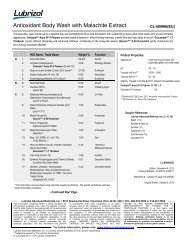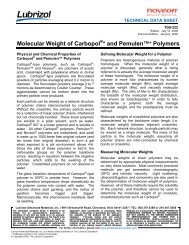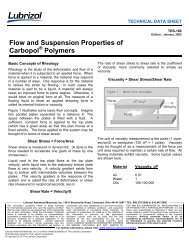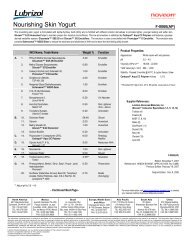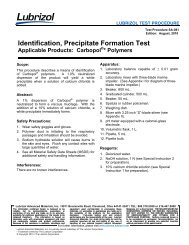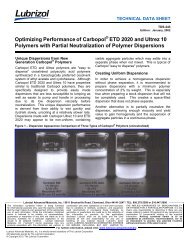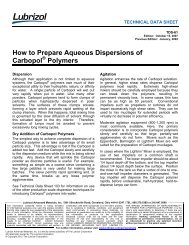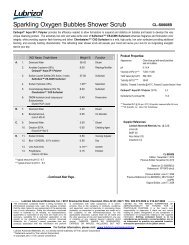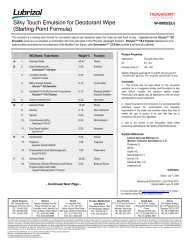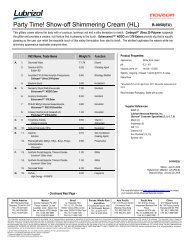Rheology Modification of Hydrogen Peroxide Based ... - Lubrizol
Rheology Modification of Hydrogen Peroxide Based ... - Lubrizol
Rheology Modification of Hydrogen Peroxide Based ... - Lubrizol
Create successful ePaper yourself
Turn your PDF publications into a flip-book with our unique Google optimized e-Paper software.
1. Key Words:<br />
<strong>Rheology</strong> <strong>Modification</strong> <strong>of</strong><br />
<strong>Hydrogen</strong> <strong>Peroxide</strong>-<strong>Based</strong> Applications<br />
Using Cross-Linked<br />
Polyacrylic Acid Polymers *<br />
Julie Schmucker-Castner and Dilip Desai<br />
The BFGoodrich Company<br />
<strong>Hydrogen</strong> <strong>Peroxide</strong>, Hair Bleach, Two-Part Hair Color, <strong>Rheology</strong> <strong>Modification</strong>, Thickened<br />
<strong>Hydrogen</strong> <strong>Peroxide</strong>, <strong>Hydrogen</strong> <strong>Peroxide</strong> Gels, <strong>Hydrogen</strong> <strong>Peroxide</strong> Stability, Cross-Linked<br />
Polyacrylic Acid, Carbomer, Acrylates / C10-30 Alkyl Acrylate Crosspolymer<br />
2. Summary:<br />
A fundamental study <strong>of</strong> the stability <strong>of</strong> hydrogen peroxide-based gels, thickened using cross-linked<br />
polyacrylic acid polymers, will be presented. Recent systematic experiments will demonstrate that<br />
excellent long-term stability <strong>of</strong> such gels can be achieved. The study evaluates different types <strong>of</strong> crosslinked<br />
polyacrylic acid polymers (as well as an associative acrylic polymer), several commercial<br />
sources <strong>of</strong> hydrogen peroxide, hydrogen peroxide concentrations and the effect <strong>of</strong> pH.<br />
Resulting viscosities from combinations <strong>of</strong> these variables will be presented, as well as the effects <strong>of</strong><br />
accelerated aging on percent active peroxide and viscosity <strong>of</strong> the thickened peroxide gels. The results<br />
<strong>of</strong> this study will enable the formulator to determine the appropriate polymer and conditions necessary<br />
for optimal stability and rheological properties for hydrogen peroxide applications. This study will<br />
demonstrate that some cross-linked polyacrylic acid polymers are very compatible and stable with H 2<br />
O 2<br />
and that these polymers do not affect the H 2<br />
O 2<br />
stability under certain conditions. In addition, this<br />
study will show that certain cross-linked polyacrylic acid polymers can produce very viscous gels and<br />
yield higher viscosities in typical permanent hair color formulas compared to many commercially<br />
available products. Because <strong>of</strong> the excellent compatibility and stability demonstrated, cross-linked<br />
acrylic acid polymers are ideal rheological modifiers for hydrogen peroxide-based applications. The<br />
performance benefits <strong>of</strong> using a cross-linked acrylic acid polymer in two-part hair color formulations<br />
will be described in detail.<br />
3. Introduction:<br />
<strong>Hydrogen</strong> peroxide has been widely used as an oxidizer and bleach in hair care applications since<br />
the 1940s. <strong>Hydrogen</strong> peroxide is one <strong>of</strong> the most important ingredients in hair color and permanent<br />
wave products on the market today. The performance characteristics <strong>of</strong> numerous peroxide applications,<br />
including household, personal care, and pharmaceutical products could be potentially improved<br />
by the use <strong>of</strong> an appropriate rheological additive. Possible applications for gelled peroxide include hair<br />
bleach, topical gels, acne treatments, dental tooth whiteners, permanent waves and permanent hair<br />
color. Although the focus <strong>of</strong> this study will be on personal care applications, particularly hair bleach<br />
and permanent hair color, the results can be leveraged broadly for other applications.<br />
*Presented at the Society <strong>of</strong> Cosmetic Chemists Conference, December 1997, New York and at the<br />
Society <strong>of</strong> Cosmetic Scientists Conference, April 1998, London, UK<br />
1
<strong>Hydrogen</strong> peroxide, because <strong>of</strong> its reactive chemistry, is difficult to stabilize in many applications.<br />
There are many commonly-used formulation ingredients that are incompatible with hydrogen peroxide.<br />
Careful selection <strong>of</strong> formula ingredients, thickeners, and stabilizers, as well as the proper order <strong>of</strong><br />
addition, pH and processing equipment are all essential to ensure acceptable long-term physical and<br />
chemical stability <strong>of</strong> a finished product.<br />
Achieving both the desired viscosity and appropriate rheological properties can be a challenging task<br />
in peroxide-based formulations. Although cross-linked polyacrylic acid polymers are currently being<br />
used in some hydrogen peroxide-containing personal care and topical pharmaceutical applications, few<br />
systematic studies have been performed to evaluate different cross-linked acrylic acid polymers for<br />
specific hydrogen peroxide applications. This fundamental study demonstrates that excellent long-term<br />
stability <strong>of</strong> hydrogen peroxide-based gels thickened with particular cross-linked polyacrylic acid<br />
polymers can be achieved.<br />
4. Cross-Linked Polyacrylic Acid Polymers<br />
Cross-linked acrylic acid polymers are already well known for their unique rheological properties,<br />
such as the ability to impart vertical cling or a “no-drip” rheology. These unique rheological properties<br />
can enhance the performance characteristics <strong>of</strong> applications such as hair bleach, permanent waves and<br />
hair color, to name a few. One <strong>of</strong> the problems that can occur during the application <strong>of</strong> a permanent<br />
wave or hair color is the unpleasant experience <strong>of</strong> having the solution drip on the neck or face. The<br />
unique rheological behavior <strong>of</strong> cross-linked acrylic acid polymers enables the active material to adhere<br />
to the substrate for consistent coverage, minimizing the amount which may be lost due to run<strong>of</strong>f.<br />
Cross-linked acrylic acid polymers also provide a shear thinning rheology with the ability to recover<br />
viscosity immediately after the shearing has ceased, allowing hair color to be easily applied or squeezed<br />
out <strong>of</strong> a bottle. In addition, cross-linked acrylic acid polymers are odor free and have a high buffering<br />
capability due to the high number <strong>of</strong> carboxylic acids groups on the polymer, helping to maintain a<br />
stable pH in the finished product and during its use.<br />
5. Fundamental Study :<br />
5.1 Experimental Approach:<br />
<strong>Hydrogen</strong> peroxide gel samples were made to determine the effects <strong>of</strong> different acrylic acid polymers<br />
and hydrogen peroxide grades. Physical properties and the stability <strong>of</strong> the gels were measured and<br />
observed. The material variables in the study include various acrylic acid polymers and hydrogen<br />
peroxide grades. Ammonium hydroxide was used to neutralize the gels where necessary. In order to<br />
minimize the introduction <strong>of</strong> any contaminants, particularly transition metals, special care was taken in<br />
this study. Samples were made using plastic beakers, agitators and spatulas, and stored in opaque<br />
polyethylene containers.<br />
The test variables in the study include H 2<br />
O 2<br />
concentration, which varied from 3 - 12 % active, and<br />
pH, from 2.7 - 4.5. This pH range was selected because <strong>of</strong> the inherent instability <strong>of</strong> hydrogen<br />
peroxide at neutral or high pH. All samples were neutralized using ammonium hydroxide to adjust the<br />
pH, except for the samples made at a pH <strong>of</strong> 2.7, which remained unneutralized. Samples were<br />
measured for percent hydrogen peroxide using a USP monograph assay for hydrogen peroxide. This<br />
method is a potassium permanganate titration, which utilizes the reduction <strong>of</strong> potassium<br />
2
permanganate by hydrogen peroxide in sulfuric acid. The samples were measured for viscosity, using<br />
a Brookfield viscometer, for pH, and were also visually observed. Teflon coated spindles were used<br />
with the Brookfield viscometer to avoid contaminating the gels. Triplicate samples <strong>of</strong> the peroxide gels<br />
were placed on stability for 12 weeks at room temperature (23 °C) and elevated temperature (45 °C).<br />
These samples were tested at intervals <strong>of</strong> 1, 2, 4, 8, and 12 weeks for the same properties as listed<br />
previously.<br />
5.2 Acrylic Acid Polymers:<br />
Five cross-linked acrylic acid polymers were used in the study, as well as a liquid associative<br />
polymer, and were labeled A through E (Figure 1). The results <strong>of</strong> this study will demonstrate that<br />
Polymers A and D have the most stable viscosity when used to gel hydrogen peroxide. Polymer A is a<br />
highly cross-linked homopolymer <strong>of</strong> acrylic acid, polymerized in benzene, and Polymer D is an easy<br />
dispersing cross-linked copolymer <strong>of</strong> acrylic acid, polymerized in ethyl acetate and cyclohexane. **<br />
Acrylic Acid Polymers Used in<br />
Current Study<br />
Polymer<br />
A<br />
B-1, B-2<br />
C<br />
D<br />
E<br />
INCI Name<br />
Carbomer<br />
Carbomer<br />
Carbomer<br />
Acrylates/ C 10-30 Alkyl Acrylate Crosspolymer<br />
Linear Acrylic Emulsion Polymer *<br />
figure 1<br />
* Not INCI Name<br />
**<br />
The following is a legend <strong>of</strong> the polymer trade names featured in this study:<br />
Polymer A Carbopol® 934<br />
Polymer B Carbopol® 980<br />
Polymer C Carbopol® Ultrez 10<br />
Polymer D Carbopol® ETD 2020<br />
Polymer E<br />
(Not supplied by BFGoodrich)<br />
3
5.3 <strong>Hydrogen</strong> <strong>Peroxide</strong>:<br />
<strong>Hydrogen</strong> peroxide is commercially available from several suppliers in a variety <strong>of</strong> grades. The<br />
grade <strong>of</strong> H 2<br />
O 2<br />
will significantly impact the performance and physical properties <strong>of</strong> the application.<br />
Commercial grades <strong>of</strong> H 2<br />
O 2<br />
contain stabilizers (chelants and sequestrants) to minimize decomposition<br />
during normal storage conditions. These stabilizers may improve the performance <strong>of</strong> H 2<br />
O 2<br />
in an<br />
application. Typical stabilizers used in hydrogen peroxide may include: colloidal stannate, sodium<br />
pyrophosphate, organo-phosphonates, and colloidal silica. Four commercially available hydrogen<br />
peroxides were used in this study, and are referred to as: A, B, C, and D (figure 2). <strong>Hydrogen</strong><br />
<strong>Peroxide</strong> A and C are both standard personal care grades, while B and D are stabilized grades.<br />
<strong>Hydrogen</strong> <strong>Peroxide</strong> B is a very highly stabilized grade. ***<br />
Commercial <strong>Hydrogen</strong> <strong>Peroxide</strong><br />
Grades Used in Study<br />
H 2<br />
O 2<br />
A<br />
B<br />
C<br />
D<br />
Description<br />
Personal Care Grade (PC)<br />
Highly Stabilized Grade (ST)<br />
Personal Care Grade (PC)<br />
Stabilized Grade (ST)<br />
<strong>Hydrogen</strong> <strong>Peroxide</strong> Concentrations Used<br />
in Commercial Hair Care Applications<br />
Volume<br />
10 Vol.<br />
20 Vol.<br />
40 Vol.<br />
60 Vol.<br />
% wt H 2 O 2<br />
3%<br />
6%<br />
12%<br />
18%<br />
figure 2 figure 3<br />
Traditionally, hydrogen peroxide solutions in the hair care industry are provided in different<br />
concentrations or “volumes” <strong>of</strong> H 2<br />
O 2<br />
. Figure 3 shows the relationship between volume and the<br />
percent by weight <strong>of</strong> H 2<br />
O 2<br />
. A concentration <strong>of</strong> 6% wt<br />
hydrogen peroxide was used in most <strong>of</strong> the<br />
study, since this is the most commonly used concentration in hair color developers.<br />
***<br />
The following is a legend <strong>of</strong> the hydrogen peroxide trade names featured in this study:<br />
<strong>Hydrogen</strong> <strong>Peroxide</strong> A<br />
<strong>Hydrogen</strong> <strong>Peroxide</strong> B<br />
<strong>Hydrogen</strong> <strong>Peroxide</strong> C<br />
<strong>Hydrogen</strong> <strong>Peroxide</strong> D<br />
Albone® 50 CG (DuPont)<br />
Ultra Cosmetic (Solvay Interox)<br />
Cosmetic (Degussa)<br />
Peralkali (Degussa)<br />
4
5.4 Test Formulation and Procedure:<br />
In order to evaluate the effects <strong>of</strong> several variables in this study (polymer type, pH, peroxide grade,<br />
and peroxide concentration) a standard test formula was used (figure 4). Using this test formula, the<br />
active polymer concentration was kept constant at 1.0 % wt<br />
, as well as the hydrogen peroxide<br />
concentration at 6 % active. The H 2<br />
O 2<br />
concentration was varied in a few experiments in order to<br />
determine the effect peroxide concentration has. The test formula was made using the following order<br />
<strong>of</strong> addition: deionized water, polymer, hydrogen peroxide, and ammonium hydroxide to adjust pH.<br />
It has been determined that this is the optimal order <strong>of</strong> addition to use in order to achieve the most<br />
stable peroxide gel system, based on previous internal studies. Samples were made in plastic beakers<br />
and mixed with plastic stirrers to avoid any contamination.<br />
Test Formulation Used in Current Study<br />
H 2 O 2 @ 6% wt active<br />
Effect <strong>of</strong> Polymer Type and pH on Viscosity<br />
100,000<br />
Order <strong>of</strong><br />
Addition Ingredients<br />
1. Deionized Water 87.0<br />
2. Polymer (% Active) 1.0<br />
3. H 2 O 2 (50%) 12.0<br />
4. NH 4 OH (30%)<br />
% wt<br />
q.s. to desired pH<br />
Brookfield<br />
Viscosity<br />
(cP )<br />
H 2<br />
O 2<br />
= A<br />
10,000<br />
1,000<br />
100<br />
10<br />
1<br />
2.7 3.6 4.0<br />
pH<br />
[ H 2 O 2 ] = 6 % wt<br />
Polymer A<br />
Polymer B-2<br />
Polymer C<br />
Polymer D<br />
Polymer E<br />
6. Results and Conclusions:<br />
6.1 <strong>Hydrogen</strong> <strong>Peroxide</strong> Thickening<br />
figure 4 figure 5<br />
Before considering what affects the long-term stability <strong>of</strong> hydrogen peroxide gels thickened with<br />
acrylic acid polymers, it is necessary to first examine what affects the initial viscosity. The results <strong>of</strong><br />
the study show how polymer type, pH, H 2<br />
O 2<br />
grade and concentration affect the initial viscosity.<br />
6.1.1 Effect <strong>of</strong> pH<br />
The effect <strong>of</strong> pH on viscosity <strong>of</strong> a 6 % wt<br />
hydrogen peroxide solution is shown in figure 5. As<br />
noted earlier, all polymers are used in this study at 1 % active. Unneutralized dispersions <strong>of</strong> crosslinked<br />
acrylic acid polymers, at pH 2.7, have a very low viscosity, ranging from 10 - 50 cP. Partially<br />
neutralized dispersions, at a pH <strong>of</strong> 3.6 and 4.0, produced viscosity ranges <strong>of</strong> 12,000 - 35,000 cP and<br />
25,000 - 45,000 cP, respectively. As the pH <strong>of</strong> a dispersion increases, the resulting viscosity also<br />
increases. Low viscosity dispersions, at pH 2.7, may be useful in applications where two-part<br />
systems are desired, making it easy to mix the two parts together. It is well known in industry that<br />
cross-linked acrylic acid polymers cause an increase in viscosity as the pH is increased. The fact that<br />
these polymers can thicken at a low pH (3.6), as shown in figure 5 however, is not expected by many<br />
formulators.<br />
6.1.2 Effect <strong>of</strong> Polymer Type<br />
Figure 5 also shows the effect <strong>of</strong> polymer type on viscosity. Polymers A through D all follow a<br />
similar viscosity pr<strong>of</strong>ile, with Polymer C providing the highest viscosity (45,000 cP), at a pH <strong>of</strong> 4.0.<br />
The cross-linked polymers, A through D, demonstrate very efficient thickening at pH 3.6 and 4.0, as<br />
compared to the liquid associative Polymer, E. Very little increase in viscosity occurs with<br />
Polymer E at a pH <strong>of</strong> 3.6 and 4.0. No dispersion was made with Polymer E, at pH 2.7, since the<br />
unneutralized dispersion pH for this polymer was 3.6.<br />
6.1.3 Effect <strong>of</strong> <strong>Hydrogen</strong> <strong>Peroxide</strong> Grade<br />
5
The grade <strong>of</strong> hydrogen peroxide used has a major influence on the initial viscosity. The effect <strong>of</strong><br />
different peroxide grades, using Polymer C to thicken 6 % wt<br />
hydrogen peroxide solutions, is<br />
demonstrated in figure 6. This example shows that the personal care grades ( A and C) <strong>of</strong> H 2<br />
O 2<br />
, result<br />
in comparable and significantly higher viscosities as compared to the stabilized grades (B and D),<br />
which differ significantly from each other. The viscosity properties in a given application are dependent<br />
on the type <strong>of</strong> H 2<br />
O 2<br />
used.<br />
Effect <strong>of</strong> <strong>Peroxide</strong> Grades on Initial Viscosity<br />
Effect <strong>of</strong> H 2 O 2 Concentration on Viscosity<br />
Brookfield<br />
Viscosity<br />
(cP)<br />
60,000<br />
50,000<br />
40,000<br />
30,000<br />
20,000<br />
10,000<br />
46,600<br />
136<br />
45,600<br />
18,800<br />
Polymer =C<br />
[ H 2 O 2 ] = 6% wt<br />
pH = 4.0<br />
pH = 3.5<br />
Brookfield<br />
Viscosity<br />
( cP )<br />
16,000<br />
14,000<br />
12,000<br />
10,000<br />
8,000<br />
6,000<br />
4,000<br />
2,000<br />
Polymer A<br />
Polymer D<br />
0<br />
A<br />
(PC)<br />
B<br />
(ST)<br />
C<br />
(PC)<br />
<strong>Peroxide</strong> Grade<br />
D<br />
(ST)<br />
H 2 O 2 = D<br />
0<br />
3.0 6.0 9.0 12.0<br />
<strong>Hydrogen</strong> <strong>Peroxide</strong> Concentration ( % wt )<br />
figure 6 figure 7<br />
6.1.4 Effect <strong>of</strong> <strong>Hydrogen</strong> <strong>Peroxide</strong> Concentration<br />
<strong>Peroxide</strong> concentration may have an effect on initial viscosity <strong>of</strong> hydrogen peroxide gels.<br />
Figure 7 shows a linear correlation between peroxide concentration and viscosity for Polymer A, but<br />
not for Polymer D. The viscosity <strong>of</strong> a peroxide gel may increase as the peroxide concentration<br />
increases, and is dependent on the type <strong>of</strong> polyacrylic acid polymer.<br />
6.1.5 Conclusions<br />
This fundamental study has determined significant effects <strong>of</strong> acrylic acid polymers on H 2<br />
O 2<br />
gels.<br />
Some cross-linked polyacrylic acid polymers can be used to make low viscosity dispersions at pH<br />
2.7, which may be useful in low-viscosity applications. Very high viscosity gels can be made at low<br />
pH's such as 3.6 and 4.0, where H 2<br />
O 2<br />
is most stable. Cross-linked acrylic acid polymers yield<br />
significantly higher viscosity gels relative to the linear emulsion polymer, and as pH increases, the<br />
viscosity <strong>of</strong> the peroxide gel also increases. The grade <strong>of</strong> H 2<br />
O 2<br />
affects viscosity, with personal care<br />
grades yielding comparable and significantly higher viscosities compared to stabilized grades. H 2<br />
O 2<br />
concentration may also affect viscosity, but is polymer dependent.<br />
6.2 Accelerated Aging<br />
One <strong>of</strong> the most important steps in the formulating process is to perform stability testing to insure<br />
that the final product will perform consistently over its expected shelf life. The results <strong>of</strong> this study<br />
show how acrylic acid polymers affect the stability <strong>of</strong> hydrogen peroxide and the resulting viscosity.<br />
6.2.1 <strong>Hydrogen</strong> <strong>Peroxide</strong> Stability<br />
It is important to first understand what makes hydrogen peroxide inherently unstable.<br />
Decomposition <strong>of</strong> H 2<br />
O 2<br />
is caused by elevated temperature, UV light, high pH, and contaminants, such<br />
as transition metals (copper, manganese and iron), as well as many common organic materials.<br />
Therefore, it is important to limit the potential environmental stresses on H 2<br />
O 2<br />
, such as heat, sunlight,<br />
and dust. It is also necessary to use passivated stainless steel equipment and high quality water, and<br />
6
to formulate with other essential ingredients, such as rheology modifiers, that are compatible with<br />
hydrogen peroxide. Synthetic acrylic acid-based polymers are very compatible with H 2<br />
O 2<br />
, as<br />
compared to natural polymers. The following results show what effect polymer type, pH, and H 2<br />
O 2<br />
concentration have on hydrogen peroxide stability when thickened with acrylic acid polymers.<br />
No loss <strong>of</strong> hydrogen peroxide, at pH 4.0, for a 6.0 % wt<br />
gel was observed after 12 weeks<br />
accelerated stability, at 45 °C, for Polymers A through D (figure 8). The cross-linked polymers have<br />
no effect on H 2<br />
O 2<br />
stability, but the linear emulsion polymer causes about 7.0% H 2<br />
O 2<br />
loss after 12<br />
weeks. The accuracy <strong>of</strong> this assay is +/- 0.15 %. Figure 9 shows the effect <strong>of</strong> harsh conditions on<br />
H 2<br />
O 2<br />
stability. The gels, thickened in this example by Polymer D, are put under very severe test<br />
conditions: a range <strong>of</strong> peroxide levels, a high pH (4.5), and accelerated stability at 45 °C for 24 weeks.<br />
The results show no loss <strong>of</strong> H 2<br />
O 2<br />
over time, even at high pH and peroxide levels. The slight increase<br />
in H 2<br />
O 2<br />
can be explained by the evaporation <strong>of</strong> water in the gel samples that may have occurred over<br />
time during the high temperature test.<br />
Effect <strong>of</strong> Elevated Temperature on H 2 O 2 Stability<br />
Effect <strong>of</strong> Elevated Temperature and H 2 O 2<br />
Polymer A<br />
Concentration on H 2 O 2 Stability<br />
Polymer B-2<br />
6.50<br />
Polymer C<br />
Polymer = D<br />
pH = 4.0<br />
Polymer D<br />
13<br />
[H 2<br />
O 2<br />
] = 6% wt Polymer E<br />
12<br />
6.25<br />
<strong>Hydrogen</strong><br />
<strong>Peroxide</strong><br />
Concentration<br />
( % wt )<br />
H 2O 2 = A<br />
6.00<br />
5.75<br />
5.50<br />
0 4 8 12<br />
Weeks @ 45 ϒC<br />
<strong>Hydrogen</strong><br />
<strong>Peroxide</strong><br />
Concentration<br />
( % wt<br />
)<br />
H 2<br />
O 2<br />
= D<br />
11<br />
10<br />
9<br />
8<br />
7<br />
6<br />
5<br />
4<br />
3<br />
2<br />
0 4 8 12 16 20 24<br />
Weeks @ 45 ϒC<br />
figure 8 figure 9<br />
H 2O 2 3.0%,<br />
pH 3.5<br />
H 2O 2 6.0%,<br />
pH 3.5<br />
H 2<br />
O 2<br />
9.0%,<br />
pH 3.5<br />
H 2O 2 12.0%,<br />
pH 3.5<br />
H 2O 2 12.0%,<br />
pH 4.5<br />
From the results <strong>of</strong> this part <strong>of</strong> the study, it can be concluded that cross-linked acrylic acid polymers<br />
do not cause loss <strong>of</strong> hydrogen peroxide at elevated temperatures for 12 weeks, but that the linear<br />
emulsion polymer does cause the loss <strong>of</strong> about 7 % H 2<br />
O 2<br />
. Harsh conditions, such as high pH (4.5),<br />
high peroxide concentrations (12 % wt<br />
), and elevated temperature (45 °C) for 24 weeks do not cause<br />
any loss in H 2<br />
O 2<br />
. <strong>Hydrogen</strong> peroxide decomposition, at higher pH ranges however, is likely to occur<br />
with any formula, due to the inherent instability <strong>of</strong> hydrogen peroxide at neutral or high pH.<br />
6.2.2 Viscosity Stability<br />
There are several factors which influence the viscosity stability <strong>of</strong> hydrogen peroxide gels thickened<br />
with acrylic acid polymers. The results will show that polymer selection, grade and concentration <strong>of</strong><br />
H 2<br />
O 2, and pH affect the peroxide gel viscosity stability.<br />
7
The effect <strong>of</strong> polymer type on viscosity stability at elevated temperature for 12 weeks @ pH 3.5 is<br />
shown in figure 10. It is evident from this graph that Polymer A maintains the most consistent<br />
viscosity pr<strong>of</strong>ile at elevated temperature over a 12 week period as compared to the other polymers.<br />
Polymer D also shows a consistent viscosity pr<strong>of</strong>ile for up to 8 weeks, after which about 20% loss <strong>of</strong><br />
viscosity occurs. Polymers A and D were selected for additional experiments because <strong>of</strong> the stability<br />
data that was observed at 8 weeks.<br />
Effect <strong>of</strong> Polymer Type on Viscosity Stability<br />
Effect <strong>of</strong> H 2 O 2 Grade on Viscosity Stability<br />
25,000<br />
H<br />
pH = 3.5 25,000<br />
2<br />
O 2<br />
D<br />
Polymer A<br />
[ H 2<br />
O 2<br />
] = 6% wt<br />
20,000<br />
15,000<br />
Polymer B-1<br />
Polymer C<br />
Polymer D<br />
Polymer = D<br />
pH = 3.6<br />
20,000<br />
15,000<br />
H 2O 2 A<br />
Brookfield<br />
Viscosity<br />
( cP )<br />
10,000<br />
5,000<br />
Brookfield<br />
Viscosity<br />
( cP )<br />
10,000<br />
5,000<br />
0<br />
0 2 4 6 8 10 12<br />
0<br />
0 2 4 6 8 10 12<br />
H 2<br />
O 2<br />
= D<br />
Weeks @ 45 ϒC<br />
Weeks @ 45 ϒC<br />
figure 10 figure 11<br />
It has been shown that the grade <strong>of</strong> hydrogen peroxide can impact the initial viscosity. The<br />
following results show how the H 2<br />
O 2<br />
grade can impact viscosity stability. Figure 11 shows the<br />
viscosity stability <strong>of</strong> a H 2<br />
O 2<br />
gel made with Polymer D at a pH <strong>of</strong> 3.6, using a stabilized and personal<br />
care grades <strong>of</strong> hydrogen peroxide (A and D). Although the gel made with the personal care<br />
grade (A) produces a higher initial viscosity (24,000 cP), than the viscosity (15,000 cP) produced<br />
using the stabilized grade (D), the viscosity loss using the stabilized grade is minimal compared to the<br />
personal care grade.<br />
The results in this paper have already shown that Polymer A has a very stable viscosity pr<strong>of</strong>ile as<br />
compared to the other polymers at H 2<br />
O 2<br />
concentration <strong>of</strong> 6 % active. The next graph, figure 12,<br />
illustrates the effect that high H 2<br />
O 2<br />
concentrations have on viscosity stability. This graph shows that<br />
even at very high H 2<br />
O 2<br />
concentrations (12 wt<br />
%), the viscosity is very stable for up to 12 weeks. If the<br />
study is extended however, viscosity loss eventually occurs, as shown by the 9 and 12 wt<br />
%<br />
concentrations.<br />
Effect <strong>of</strong> H 2 O 2 Concentration on Viscosity Stability<br />
Effect <strong>of</strong> pH on Viscosity Stability<br />
Polymer = A<br />
pH = 3.5<br />
Brookfield<br />
Viscosity<br />
( cP )<br />
H 2 O 2 = D<br />
20,000<br />
15,000<br />
10,000<br />
5,000<br />
Stable<br />
0<br />
0 2 4 6 8 10 12 14 16<br />
Weeks @ 45 ϒC<br />
H 2 O 2 3.0%<br />
H 2 O 2 6.0%<br />
H 2 O 2 9.0%<br />
H 2 O 2 12.0%<br />
Polymer = D<br />
[ H 2 O 2 ] = 6.0% wt<br />
%<br />
Viscosity<br />
Stability<br />
H 2 O 2 = D<br />
100<br />
90<br />
80<br />
70<br />
60<br />
50<br />
40<br />
30<br />
20<br />
10<br />
0<br />
4 8 12<br />
Weeks @ 45 ϒC<br />
figure 12 figure 13<br />
pH = 3.5<br />
pH = 4.0<br />
pH = 4.5<br />
8
The effect <strong>of</strong> pH on viscosity stability was the final factor that was studied . Figure 13 shows the<br />
percent viscosity stability at 45 °C using Polymer D at pH’s <strong>of</strong> 3.5, 4.0, and 4.5 at time intervals <strong>of</strong> 4,<br />
8, and 12 weeks. No viscosity loss was observed at pH 3.5 after eight weeks, but about<br />
15 - 35 % relative loss was observed at pH 4.0 and 4.5.<br />
From these results, conclusions can be drawn about how the viscosity stability <strong>of</strong> hydrogen<br />
peroxide gels thickened with acrylic acid polymers is affected. Polymers A and D provide the most<br />
consistent viscosity stability over time for hydrogen peroxide gels. The grade <strong>of</strong> H 2<br />
O 2<br />
has a significant<br />
impact on stability. <strong>Hydrogen</strong> <strong>Peroxide</strong> D, one <strong>of</strong> the stabilized grades, demonstrates superior<br />
viscosity stability compared to the personal care grade (A), although the personal care grade may give<br />
a higher viscosity response. As the concentration <strong>of</strong> H 2<br />
O 2<br />
and pH is increased, the viscosity stability<br />
decreases.<br />
7. Application <strong>of</strong> Results:<br />
The results in this paper have demonstrated that excellent long-term stability <strong>of</strong> hydrogen peroxidebased<br />
gels, thickened with cross-linked polyacrylic acid polymers can be achieved. The next logical<br />
step in the study was to see how this information could be practically applied to hydrogen peroxide<br />
applications. Cross-linked acrylic acid polymers, due to their unique rheological properties, could<br />
enhance the performance characteristics <strong>of</strong> a broad range <strong>of</strong> applications. Additional experiments were<br />
completed to determine if the results obtained from this study could be used for the application <strong>of</strong> twopart<br />
permanent hair color.<br />
7.1 Permanent Hair Color:<br />
Permanent hair color consists <strong>of</strong> two parts: a high pH color phase , and a low pH developer phase,<br />
that contains hydrogen peroxide. The two parts are mixed together prior to application on hair, where<br />
the H 2<br />
O 2<br />
is activated at high pH. Figure 14 lists some <strong>of</strong> the key requirements <strong>of</strong> each phase as well as<br />
the mixture. Cross-linked acrylic acid polymers may <strong>of</strong>fer several unique benefits to enhance the<br />
current performance properties as summarized in figure 14.<br />
7.1.1 Mock Hair Color Test<br />
In order to evaluate the high pH thickening properties <strong>of</strong> the acrylic acid polymers with hydrogen<br />
peroxide, a mock hair color test was developed to screen potential polymers. The test formula<br />
consisted <strong>of</strong>:<br />
“Developer” :<br />
pH = 2.7<br />
“Dye” :<br />
pH = 12<br />
Deionized Water (Q.S.)<br />
1 % active polymer<br />
6 % active H 2<br />
O (A) 2<br />
Deionized Water (Q.S.)<br />
8 % Ammonium Hydroxide<br />
The two parts were mixed together (dye into the developer) using equal parts, and the viscosity and pH<br />
measured after 3 minutes. The final pH <strong>of</strong> the mixture was 10, and the active polymer concentration<br />
was 0.5% wt<br />
.<br />
9
Permanent Hair Color Requirements<br />
Viscosity Results <strong>of</strong> “Hair Color” Mixture<br />
Dye<br />
Low or high viscosity<br />
Easily mixed with developer<br />
Stable<br />
Low cost<br />
Developer<br />
Low viscosity<br />
Easily mixed with dye<br />
Stable<br />
Low cost<br />
Unique Benefits<br />
• Higher viscosity<br />
• Gel-like rheology<br />
• Vertical cling - “no drip” rheology<br />
• Shear-thinning properties<br />
• Adheres to substrate<br />
• Lower surfactant actives?<br />
Mixture<br />
Thicken<br />
pH buffered<br />
Rapid penetration <strong>of</strong> dyes<br />
Easy to apply<br />
pH = 10.0<br />
Brookfield<br />
Viscosity<br />
(cP)<br />
H 2 O 2 = A<br />
Appearance:<br />
7,000<br />
6,000<br />
5,000<br />
4,000<br />
3,000<br />
2,000<br />
1,000<br />
0<br />
A<br />
Hazy<br />
870<br />
B<br />
Hazy<br />
1,295<br />
335<br />
Polymer Type @ 0.5% wt in Mixture<br />
C<br />
Hazy<br />
D<br />
Clear<br />
6,168<br />
E<br />
Hazy<br />
10<br />
figure 14 figure 15<br />
Figure 15 shows the viscosity results <strong>of</strong> the mock hair color mixture at a pH <strong>of</strong> 10.0 (+/- 0.1).<br />
Viscosity results ranged from 85 - 6,200 cP for Polymers A through D, to 10 cP for Polymer E. The<br />
cross-linked acrylic acid polymers all show the ability to thicken hydrogen peroxide as compared to the<br />
liquid associative polymer. Associative polymers, unlike cross-linked acrylic acid polymers, require<br />
high amounts <strong>of</strong> surfactants to achieve thickening at high pH. What is interesting and unexpected is<br />
the unusually high viscosity response Polymer D gives in this test compared to the other polymers.<br />
Another unexpected result was the observation that Polymer D produces very clear gels in this test as<br />
compared to the other polymers which produced hazy gels.<br />
7.1.2 Commercial Hair Color Thickening Test<br />
The mock hair color formula, which contained a cross-linked acrylic acid polymer, demonstrated<br />
that a viscous hydrogen peroxide gel could be produced at high pH using a two-part system. In order<br />
to test if the cross-linked polymers would thicken in an actual two-part hair color application,<br />
commercial hair color was used to mix with a hydrogen peroxide dispersion, containing Polymer D.<br />
Five dark brown, commercially available, two-part permanent hair colors were selected and labeled V<br />
through Z.<br />
For the first part <strong>of</strong> the test, each color was mixed with its given components according to the<br />
manufacturer’s directions. For the second test, the developer was replaced by the Polymer D<br />
Developer, which consisted <strong>of</strong> 1% wt<br />
Polymer D, and 6 % active H 2<br />
O 2<br />
@ pH 2.7. Viscosity and pH<br />
<strong>of</strong> all mixtures were measured after three minutes. Polymer D was selected as the rheology modifier<br />
<strong>of</strong> choice because <strong>of</strong> the performance characteristics at high pH demonstrated in the mock hair color<br />
formula.<br />
Viscosity Results <strong>of</strong> Commercial Hair Color Thickening Test<br />
Brookfield<br />
Viscosity<br />
( cP )<br />
35,000<br />
~<br />
10,000<br />
8,000<br />
6,000<br />
4,000<br />
2,000<br />
1,230<br />
7,470<br />
2,160 2,500<br />
4,410<br />
34,550<br />
3,200<br />
6,540<br />
Commercial<br />
Developer<br />
"Polymer D"<br />
Developer<br />
1,580<br />
7,630<br />
H 2 O 2 = A<br />
pH = 2.7<br />
V W X Y Z<br />
Commercial Hair Color Mixtures<br />
figure 16<br />
The results <strong>of</strong> the experiment show that the Polymer D developer produces much higher viscosities<br />
10
as compared to the commercial developer provided with each hair color. For example, figure 16<br />
shows that the viscosity <strong>of</strong> the Hair Dye V mixture was 1,230 cP for the commercial developer, and<br />
7,470 cP for the Polymer D Developer. The resulting pH’s <strong>of</strong> all mixtures, made with the<br />
experimental developer, were comparable to the commercial mixtures. From this experiment, it can be<br />
concluded that Polymer D performs in actual hair color formulas and yields higher viscosities<br />
compared to those produced by the commercial developer.<br />
8. Final Conclusions:<br />
The results <strong>of</strong> this study have demonstrated that certain cross-linked acrylic acid polymers <strong>of</strong>fer key<br />
advantages in hydrogen peroxide applications. Some polymers are very stable in hydrogen peroxide<br />
and can provide the ability to produce viscous gels at low pH (3.6). In addition, stable low viscosity<br />
hydrogen peroxide solutions, containing a particular cross-linked acrylic acid polymer (D), can be<br />
made which will thicken when exposed to high pH. Unique clear gels can be produced by some <strong>of</strong> the<br />
cross-linked polymers.<br />
One <strong>of</strong> the cross-linked acrylic acid polymers (D), is an ideal thickener for use in two-part<br />
permanent hair color applications due to the shear-thinning rheology and vertical cling, or “no drip”<br />
rheology. The results <strong>of</strong> this study show that Polymer D, which is an easy-dispersing acrylic acid<br />
copolymer, is an ideal choice for hair color applications. Polymer D produces a very low dispersion<br />
viscosity at low pH (2.7), which is necessary for a peroxide developer, and can also make a stable<br />
viscous gel at a pH <strong>of</strong> 3.6, which is optimal for a hair bleach gel. Polymer D is an excellent choice to<br />
thicken peroxide-containing systems, with or without surfactants, because <strong>of</strong> its efficient viscosity<br />
building characteristics and clarity when exposed to high pH environments.<br />
9. Acknowledgments:<br />
The authors wish to recognize the Consumer Specialty Division <strong>of</strong> BFGoodrich, and in particular<br />
the following individuals for their hours <strong>of</strong> lab work, research, help and support: Dr. Lynn Soby,<br />
Ashley Weaver, Kittie Ramey, Susan Morgan, Sahira Kotian, Hal Ambuter, Debra Light, and Joel<br />
Ross.<br />
10. References:<br />
Amjad, Z., Hemker,W., and Maiden, C. “Carbomer Resins: Past, Present, and Future”. Cosmetics<br />
and Toiletries 1-7 85-85 (1992).<br />
Arai, Y., Yasuda, M. “Two component cosmetics”. Japanese Patent Hei 9-2925. Shiseido, Tokyo<br />
(1997).<br />
Cohen, D., Hitchcock, E., Pohl, S. “Two-part aqueous composition for coloring hair, which form a<br />
gel on mixing <strong>of</strong> the two parts”. US patent 5393305. Bristol-Myers Squibb Company, New York<br />
(1995).<br />
El Assay, A.I., Elbary, A.A., and Hamza, Y.H. “Stability <strong>of</strong> <strong>Hydrogen</strong> <strong>Peroxide</strong> in Certain<br />
Pharmaceutical Gels”. Cosmetic and Toiletries. 91 54-56 (1976).<br />
Knowlton, J., & Pearce, S. Handbook <strong>of</strong> Cosmetic Science and Technology. 1st ed. Oxford,<br />
Elsevier, 1993.<br />
Urbano, C. C. “50 Years <strong>of</strong> Hair Care Development”. Cosmetics and Toiletries. 110 85-104 (1995).<br />
Wetmur, K., and Jeff, M. “Formulating with <strong>Hydrogen</strong> <strong>Peroxide</strong>”. Happi. 52-56 (February 1997).<br />
11




